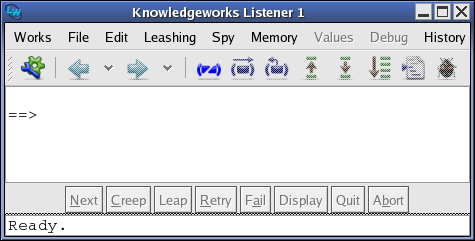





KnowledgeWorks Listener

The KnowledgeWorks Listener is obtained by choosing KnowledgeWorks > Listener. This tool is based on the LispWorks Common Prolog Logic Listener (see Appendix A: Common Prolog for further details). Input is taken as being a goal expression to be satisfied unless no predicate of that name and arity (number of arguments) exists in which case it is taken as a Lisp expression. That is, the input may be either:
<expression>
as defined in 3.1 Forward chaining, or:
<lisp-expr>
with the former interpretation taking priority when ambiguous. Interaction is Prolog-style, so when the bindings which satisfy a goal are printed, pressing Return terminates execution, and entering ; (semi-colon) and Return (or just clicking on the Next button at the bottom) looks for the next solution to the goal.
The File, Leashing and Spy menus behave as for the Common Prolog Logic Listener (see Appendix A: Common Prolog) and the Values, Debug and History menus behave as for the Lisp Listener (see the LispWorks IDE User Guide).
KnowledgeWorks and Prolog User Guide (Unix version) - 01 Dec 2021 19:35:49